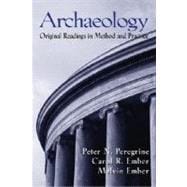
Note: Supplemental materials are not guaranteed with Rental or Used book purchases.
Purchase Benefits
What is included with this book?
I. ARCHAEOLOGICAL METHODS.
1. The Discovery of Archaeological Sites, S. Ball.II. ISSUES AND CONTROVERSIES IN CONTEMPORARY ARCHAEOLOGY.
10. Were Our Ancestors Hunters or Scavengers?, J. Speth.III. ARCHAEOLOGICAL CASE STUDIES.
17. Cloth Production and Gender Relations in the Inka Empire, C.L. Costin.IV. ARCHAEOLOGISTS AT WORK.
24. Archaeologist at Work, R. Blanton.The New copy of this book will include any supplemental materials advertised. Please check the title of the book to determine if it should include any access cards, study guides, lab manuals, CDs, etc.
The Used, Rental and eBook copies of this book are not guaranteed to include any supplemental materials. Typically, only the book itself is included. This is true even if the title states it includes any access cards, study guides, lab manuals, CDs, etc.